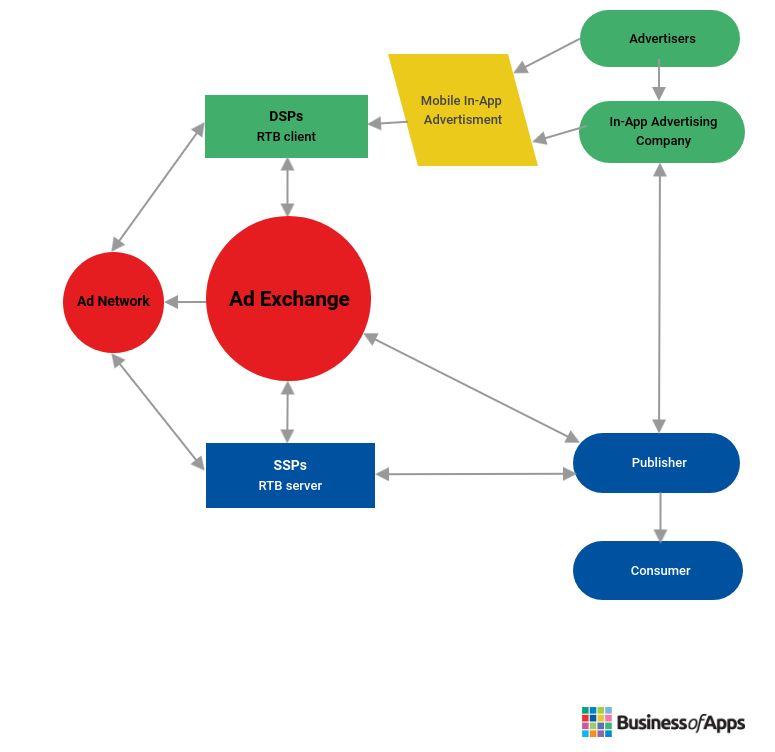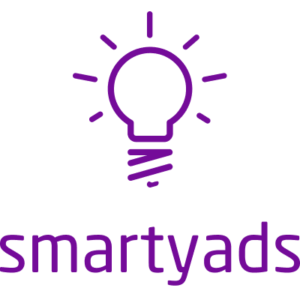Gaming, entertainment, social media, and subscription-based apps all drive huge revenues from in-app advertising. And since many more of us are spending more time on devices, in-app advertising offers a targeted and measurable way to capture audiences’ attention.
It’s a format that works both for app publishers and the advertisers who use them. But you will need support from the best in-app advertising companies to succeed. Because, in partnership with in-app advertising companies, publishers and advertisers can produce impressive creatives and plan better strategies.
So how can you connect with the top in-app advertising companies and get the help you need?
In this guide, we’ll outline some of the benefits of in-app advertising. But we’ll also showcase a complete list of in-app advertising companies that are ready to get you higher revenues from your campaigns.
What is in-app advertising?
In-app advertising is a mobile advertising strategy used to drive revenues by marketing on apps. By allowing advertisers to advertise their products and services to app users, app publishers drive revenues that ensure their apps stay free to download. Mobile advertisers who use this method often use pay-per-click strategies. And these help with targeting specific audiences.
Mobile advertising revenues are growing every year. And in 2022 and 2023 they’re expected to grow large enough to overtake desktop advertising as the most popular platform. In-app advertising forms a large percentage of this trend and is likely to continue to rise over time.
Global online ad spending desktop vs mobile percentage, 2018 – 2023 (%)
Source: Statista
How does advertising on an app work?
When an in-app ad is well-placed, it increases sales and improves engagement for app publishers. Often, free-to-download apps make their money from publishing in-app ads and running advertiser promotions. But many also offer opportunities to integrate the app user experience, for instance enabling in-app purchases as a feature.
Top In-App Advertising Companies
Advertisers who want to generate revenue from in-app advertising often use mobile app advertisements to generate brand awareness, increase app installs and boost sales.
To show you more, here’s an illustration of how in-app advertising works across all functions:
Model of How In-App Advertising Works
Advertisers: Marketers will either have their own team members or reach out to an in-app advertising company to create mobile in-app ads. From there, a demand-side platform (DSP) will aggregate campaigns from multiple advertisers, and then offer them up to app publishers.
App publishers: Developers and app owners can integrate with a source of advertiser demand, either direct or with a supply-side platform (SSP) that aggregates publisher supply.
Ad networks: Ad networks bridge the two sides. An ad network connects advertisers and their partners with publishers and their partners. Brands choose an ad network that helps them reach their target audience by working across lots of apps.
What are some in-app advertising formats?
From display ads to incentivized ads, in-app advertising is available in a range of formats that help to attract views and clicks. Here’s a selection of the most popular ones that in-app advertising companies use:
Banner ads
Banner ads are traditional display ads that run across the top of an app page. They often appear in a rectangular shape and take up a section of an app layout. Usually, they remain on the screen and refresh themselves as users interact with an app.
Banner ads are usually available as either CPM (Cost-Per-Mile) or CPC (Cost-Per-Click). And due to the abundance of banner ads, many people suggest their popularity may be in decline.
Interactive video ads
Due to their rising popularity among consumers, more marketers are moving towards using interactive video ads. According to Spiel Creative, almost 80% of marketing professionals saw better online sales when they used interactive video over traditional video.
Marketers who increased sales with interactive video ads

Source: Spiel Creative
Some examples of different types of interactive video ads include gamified or playable ads, AR ads, and branched stories.
Rich-Media ads
Rich-media ads offer marketers the chance to blend interactive video ad features with CTA’s and display audio or video. They’re usually more complex to design and execute but they do give marketers the chance to increase brand awareness and boost CTRs.
Interstitial ads
Interstitial ads are another type of interactive ad. But these appear in-between content, so tend to appear during an app’s transitional points. The true benefit of interstitial ads is that they appear as full-screen ads, and encourage users’ full attention.
Native ads
Native ads can be a powerful ad format due to their ability to blend into the content on screen. A good native ad won’t even appear as an ad to a user but will drive engagement rates and interactions by offering valuable content.
Incentivized ads
Also known as reward ads, incentivized ads offer a value exchange in return for action. And studies suggest users are more than 25% likely to convert when they receive valuable rewards or incentives that encourage them to stay on an app.
Offerwalls
Offerwalls give app users a choice of incentivized offers that appear as a ‘mini-store’. They often lead to higher app install rates and retention rates as much as 50% higher. They also lead to increased chances of in-app purchases.
How much does in-app advertising cost?
Understanding how much mobile app advertisements cost can help with creating budgets, planning, and deciding which in-app advertising companies are best to approach.
In-app ads pricing models
Because of the wide range of advertising formats. Many types of pricing structures exist when it comes to mobile in-app advertising. And we’ve summarized the key ones below:
- CPM – Cost Per Thousand or Mile: A low price for advertisers and great for publishers since they need to show the ad 1,000 times to get paid.
- CPA – Cost Per Action: High CPA rates are effective for publishers who want results in a short space of time. And it’s a low-risk strategy for advertisers.
- CPV – Cost Per View: Of great benefit to advertisers, since they only pay for seen videos. Publishers only need to show them to get paid.
- CPC – Cost Per Click: Perfect for advertisers who only pay when someone clicks on their ad. Publishers can sometimes ask for higher rates per click.
- CPI – Cost Per Install: Lucrative for publishers, and advertisers only pay for committed app users.
- eCPM: Effective Cost Per Mile serves as a common denominator for all these rates and splits total cost over the total number of impressions.
Examples of in-app ads rates
With an extended number of ad formats and a variety of pricing models, in-app advertising rates can have several variables. But to give you an idea of what to expect, here are some examples of average rates in 2021.
- Average Facebook CPM rates – $15
- US iOS Rewarded Video eCPM rate – $12.6
- US Android Rewarded Video eCPM rate – $13.1
- Global iOS Interstitial eCPM rates range – $2.27 – $9.64
- Global Android Interstitial eCPM rates range – $3.01 – $10.11
- Global iOS Banner eCPM rates range – $0.16 – $0.38
- Global Android Interstitial eCPM rates range – $0.16 – $0.52
What are the benefits of running in-app advertising?
Advertising in-app has a huge advantage over website advertising. Some reports suggest apps have 3x higher conversion rates over mobile websites, suggesting in-app advertising is more powerful at closing customers.
And there are plenty of other benefits too. Some of these include the following:
Increased revenue from in-app purchases
Consumers tend to engage more and buy more when they download an app. They visit an app more often, and when it comes to e-commerce they also visit physical stores more.
Offerwalls tend to yield higher revenues than other types of advertising formats. Plus, advertisers can expect to generate around $2.50 per completion compared with interstitials which garner around $0.16.
Larger audience exposure
Global app and game downloads totaled over 140 billion in 2021. Plus, the most recent reports suggest time spent on mobile apps makes up around 70% of total US digital media time.
With so many people spending most of their media time on phones, in-app advertising reaches more captive and active audiences.
Quarterly app and game downloads 2015 to 2022 (bn)
Personalized audience targeting
In-app advertising companies help with personalized audience targeting based on audience viewing metrics. For instance, they can support advertisers who want to reach a young demographic to reach their target audience on ad networks or direct with publishers.
High CTRs
With its broad reach and targeted approach, mobile in-app advertising tends to garner higher Click-Through-Rates (CTR).
A report by Smaato and Liftoff suggested mobile video in-app ads had 7.5x higher average Click-Through-Rates (CTRs) over display advertising.
Tracking performance
In-app ads make it much easier to track performance since they’re under the control of a publisher’s framework. Unlike website advertising based across multiple sites, platforms, and formats, in-app ads are easier to track.
Captive audiences
Since advertisers are selling products and services to targeted audiences, the audience is more likely to be receptive and open to the types of ads they see.
This also reduces the risk of ad blockers, since in-app advertising companies can help you to target audiences who will want to see your ads.
Improved audience experience
Mobile in-app ads fit to the screen. And this gives audiences a better visual and interactive experience than website ads.
What are the challenges of running in-app ads?
All forms of advertising come with some challenges. But the upsides tend to outweigh the downsides. Here are some key ones to consider:
Risk of lower-quality ads
With a vast number of formats available and a huge range of audience types to target, advertisers can risk producing lower-quality ads. And it’s for this reason that selecting an effective in-app advertising company is a very good idea.
CTRs not always reliable since users accidentally click
Gaining high CTRs isn’t a given with in-app advertising. You’ll need to create the right ad for the right audience. Plus, within the mechanism of running ads, there is always the risk that users make accidental clicks, which can distort your figures and not represent true results.
What do in-app advertising companies do?
In-app advertising companies offer different services based on what both advertisers and publishers are looking to achieve. These can include:
Boost User Acquisition
In-app advertising companies will work with advertisers to create targeted campaigns that increase the number of new users outside the usual social media and search channels.
End-to-end campaign management
From buying publisher inventory to approaching ad networks to handle compliance or legal requirements in different territories, in-app advertising companies will manage every programmatic aspect for you.
Creative content development
In-app advertising companies can develop exciting creative that supports sophisticated mobile in-app advertising campaigns. And those who use short-form video could expect to reach over 5 billion views when working with the right creative partner.
Campaign monitoring and dashboards
Many platforms offer real-time statistics that help to inform campaign management and strategy. Plus, they can work across the many rate and format variations to provide live data and monitoring.
What are the different types of in-app advertising companies?
There’s a huge range of different types of in-app advertising companies that can help you to run effective campaigns. So whether you’re an advertiser or publisher, here are a few options worth considering.
- DSPs: Demand-Side-Platforms sometimes draw on machine learning and AI to support advertisers with end-to-end campaign management.
- SSPs: Supply-Side-Platforms are bespoke tools suitable for publishers to source advertisers to take up their app inventory.
- Mobile ad networks: Mobile ad networks can connect with billions of users and platforms around the world.
- Online advertising platforms: These can offer a complete package of support for both advertisers and publishers, supporting them to match their needs through ad networks.
- Ad-engine-as-a-service and Saas-based: Software-as-a-Service platforms give advertisers and publishers the chance to manage campaigns and support their own growth.
Why should you work with in-app advertising companies?
In-app advertising can bring a huge number of rewards. But achieving success can be complex. With a huge variety of rates, ad formats, and apps to advertise on, advertisers and publishers need to devise creative strategies and conduct A/B testing to check that they’ve worked.
And this is where finding and connecting with top in-app advertising companies can increase your chances of engaging the right users and achieving your KPI’s.
Some other great reasons to connect with in-app advertising companies include:
- Faster acquisition
- Connect with a broader range of publishers and ad networks
- Use budgets more effectively
- Driver higher CTRs
- Gain better LTV
- Improve decision-making with real-time data and analytics
To gain better insights into what they can do to improve your campaigns, take a look through our top in-app advertising companies now.






































